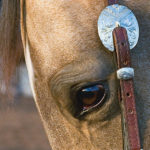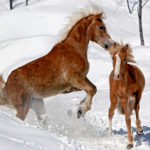
Q: Due to the drought I was unable to find Bermuda square bales last year and had to purchase round bales. It would appear I am not going to use these at the rate I had anticipated. I have them stored out of the weather and direct sunlight. At what point in time should I consider the quality to be too nutritionally degraded to feed to my horses?
A: When grasses are cut for hay, the plants continue to respire for some time, so all stored forage will experience some loss of dry matter (the fiber, proteins, sugars, vitamins, minerals and everything contained within the plant except the water). The dry matter loss is primarily a loss of soluble carbohydrates. However, most of the dry matter and nutrient losses from hay in storage occur within the first month or two. Hay typically loses only about 5 percent of its original dry matter during the first year of storage—assuming that it is kept in a dry environment, not exposed to direct sunlight or precipitation. Beyond that time frame, further losses of dry matter, protein and energy are negligible, so hay that is 12 to 24 months old will have nearly the same protein and energy value as hay that is six to eight months old.
One nutrient of particular concern is carotene, the precursor to vitamin A. In horses, vitamin A helps with cell growth and healing and is important for vision, particularly at night. The carotene concentration in hay declines rapidly, especially when exposed to sunlight, and much of that loss occurs within the first three to six months of storage. Some loss of carotene will even occur in the field between the time of cutting and baling. It’s important to be aware of this possible deficiency when feeding horses hay that is more than a year old; a vitamin A supplement may be needed.
Of course, hay kept in storage for a long time will lose its field-fresh smell, but that will not affect its protein or energy nutritional value. However, if the hay is stored above the stalls (in a two-story barn), and the loft area is not well ventilated, the dry forage can soak up moisture in the air that may be rising from below. This creates a musty odor, and the hay may develop mold, especially in the flakes that are in direct contact with the floor. This problem is more common in the colder, northern climates, where barns may be closed up in the winter without proper ventilation.
Les Vough, PhD, Pasture and grazing management consultant, College Park, Maryland
This article first appeared in EQUUS issue 431.






